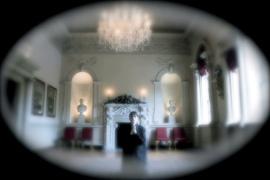
Theater Festival
One of the strangest and most beautiful shows in the Dublin Theatre Festival, which ran during the first week of October, was entitled “No Worst There Is None” and concerned the life of the English poet and Jesuit Gerard Manley Hopkins. It was performed for an audience of twenty-five who followed the actors around the rooms of Newman House on St Stephen’s Green in Dublin. This eighteenth century building, which is owned by University College Dublin, has a plaque outside commemorating three disparate figures who spent time in its lofty halls—Cardinal Newman, the first head of the National University of Ireland; James Joyce, who was a student here; and poor, depressed Hopkins, who, sent to Dublin by his order, spent the last five years of his life in the building and wrote what are called his “terrible sonnets.”
Hopkins disliked Ireland – in one poem he wrote: “I am in Ireland now; now I am at a third/Remove” —and it is possible that part of his despair arose not merely from his doubts about God, or his general malaise, but his feelings about being stuck in a country he had no sympathy for. Towards the end of the one-hour show, we were led to the very upper rooms of the building, the rooms where Hopkins must have slept and where he woke “to feel the fell of dark not day.”
Somehow, the low ceilings and the more cramped spaces conjured up a gloom all of their own; this gloom was not dispelled by the dwindling light in the city outside, the slow sense of winter coming with all its dampness, or the pervading news of the Irish economy which is in ruins. As we watched the poet in the bed, the twenty-five of us, who had bonded somewhat as we moved from room to room contemplating the precise spaces where Hopkins had felt his dark despair, had reason to join him in believing that “no worst, there is none” and asking, as he did, someone to send our roots rain.

